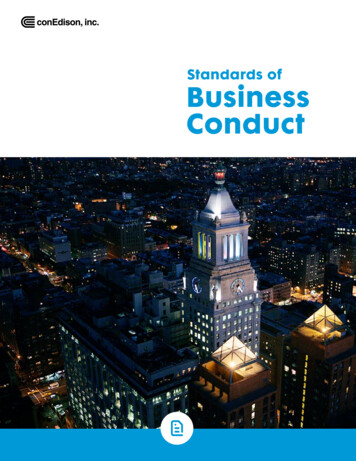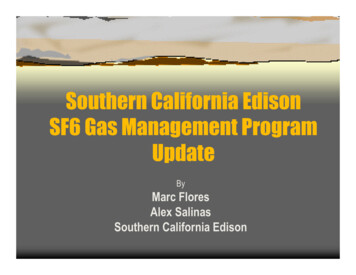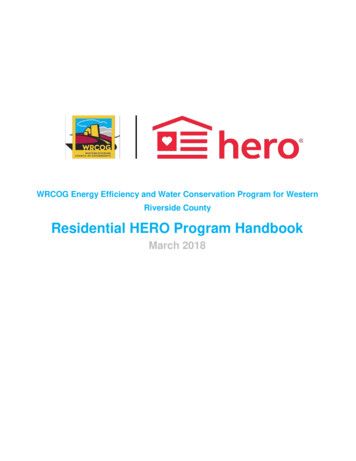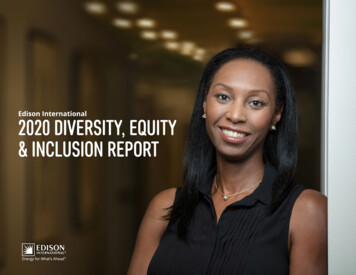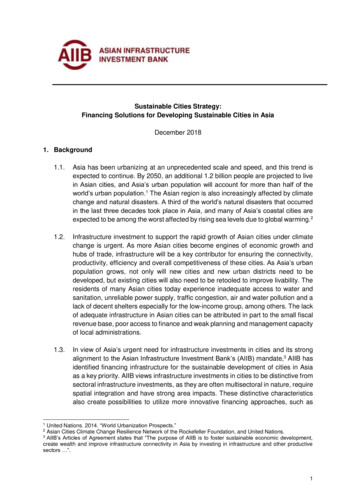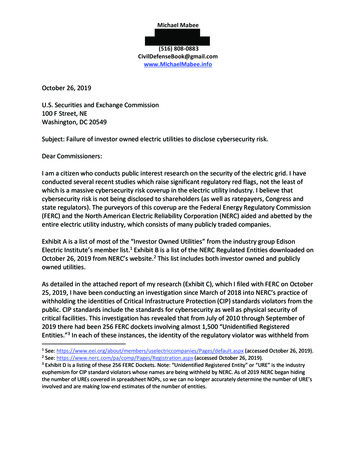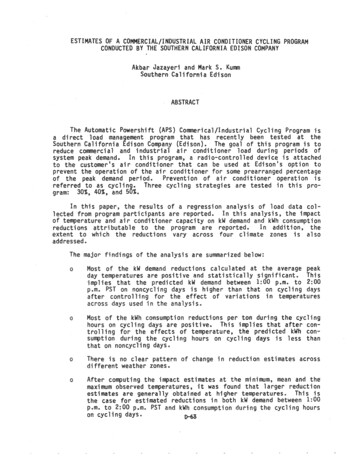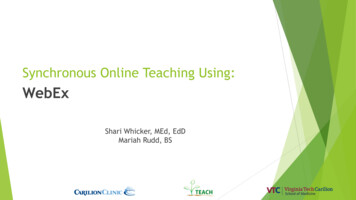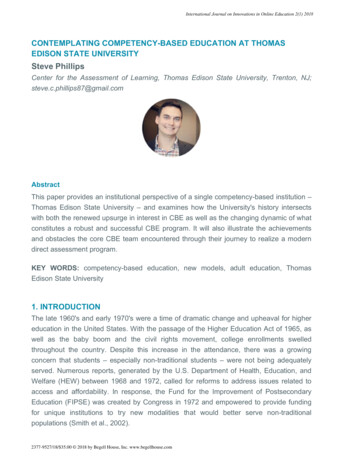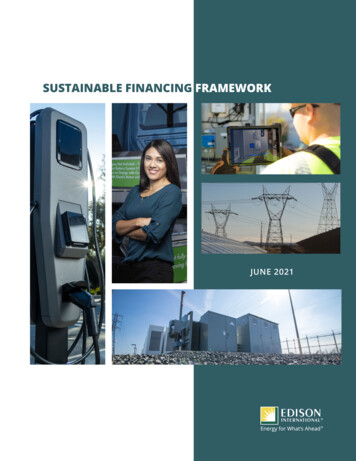
Transcription
SUSTAINABLE FINANCING FRAMEWORKJUNE 2021
TABLE OF CONTENTS1. Business Overview32. Strategy and Approach to Sustainability43. Strategic Focus Areas to Address ClimateChange and Other Priorities54. Protecting the Environment85. Contributing to the United Nations (U.N.)Sustainable Development Goals96. Edison International’s SustainableFinancing Framework106.1 Use of Proceeds106.2 Process for Evaluation and Selection136.3 Management of Proceeds146.4 Reporting146.5 External Review157. Disclaimer16On the cover page (from left to right, top to bottom): An electric vehicle charge port installed through SCE’sCharge Ready program; SCE’s Director of Vegetation & Land Management in front of an electric truck andcharge port in Long Beach, Calif.; an SCE lineworker using Augmented Reality technology to help diagnose anelectrical equipment issue; a solar farm in Lancaster, Calif., supported by the Connolly Battery Storage System,which was developed as part of an SCE energy storage pilot.
Edison International Sustainable Financing Framework1. BUSINESS OVERVIEWEdison International is one of the nation’s largest electric utility holding companies, providing cleanand reliable energy and energy services through its independent companies. Headquartered inRosemead, California, with over 13,000 employees, Edison International is the parent company ofSouthern California Edison (SCE), a utility that delivers electricity to approximately 15 million people in a50,000-square-mile service area of southern, central and coastal California.Having provided electric service in the region for 135 years, SCE is focused on accelerating cleanpower and electrification, strengthening and modernizing the grid, achieving operational and serviceexcellence and proactively mitigating climate change-related risks, including wildfires. SCE is wiresfocused, with less than 20% of electricity sales coming from its own generation. SCE has an electricrate base of approximately 33.8 billion, growing at a 7.2% compound annual growth rate (CAGR)since 2015. In 2020, SCE generated revenue of approximately 13.5 billion and core earnings ofapproximately 1.8 billion. The company improves the efficiency of its generation, transmission anddistribution operations and assets to reduce emissions and preserve natural resources. Its generationassets consist predominantly of natural gas, hydroelectric and nuclear power plants.Edison International is also the parent company of Edison Energy*, a global energy advisory companydelivering comprehensive data-driven energy solutions to commercial, institutional and industrialusers to meet their cost, sustainability and risk goals. An unregulated subsidiary, Edison Energy* wasfounded in 2013 and partners with leading commercial, institutional and industrial clients, including 15of the Fortune 50, to help them simultaneously reduce their energy costs, improve the environmentalperformance of their operations, ensure energy resiliency and manage exposure to energy price risk.Providing a suite of specialized services across sustainability, analytics, renewables, supply, demandand efficiency, Edison Energy* works with clients to help them navigate and manage three of the biggestchallenges of today: cost, carbon and the increasingly complex choices in energy.Edison Energy is not the same company as Southern California Edison, the utility, and Edison Energy is not regulated by the CaliforniaPublic Utilities Commission.*Edison International, June 20213
Edison International Sustainable Financing Framework2. STRATEGY AND APPROACH TO SUSTAINABILITYEdison International’s vision is to lead the transformation of the electric power industry toward a cleanenergy future while delivering superior value to customers and shareholders. We are focused onopportunities in clean energy, efficient electrification, the grid of the future and customer solutions.SCE is focused on accelerating clean power and the electrification oftransportation and buildings, strengthening and modernizing the grid,achieving operational and service excellence and mitigating climatechange-related risks, including wildfires. Among other things, EdisonEnergy* supports organizations globally in meeting their sustainabilitygoals through renewable energy contracting, on-site generation andenergy-efficiency investments.SCE delivers power to customers entirely within the state of California,which has some of the most ambitious science-based climatechange goals in the U.S. These goals include economywide net-zerogreenhouse gas (GHG) emissions by 2045 and net-negative thereafter,in addition to a 40% reduction in GHG emissions from 1990 levels by2030 and 80% by 2050.In 2019, SCE published Pathway 2045, a white paper demonstrating themost affordable way to achieve economywide net-zero GHG emissionsis electric-led with 100% carbon-free electricity (in terms of retail sales)powering 75% of vehicles and 70% of building space and water heating.Through partnerships, advocacy, programs and investments, SCE iscarrying out this plan, including accelerating electrification.Sustainability is at the core of Edison International’s vision. We arecommitted to doing our work with the long-term view in mind. Ourcommitment to sustainability is reflected in our environmental, socialand governance (ESG) priorities and practices, described in ourSustainability Report. The Nominating and Governance Committee ofEdison International’s Board of Directors is responsible for reviewingsignificant ESG trends that may affect the company and ensuringthat the board and its committees have the appropriate oversightof relevant ESG issues. Edison International’s SVP of Strategy andCorporate Development, who reports to the President and CEO,oversees the sustainability approach.SCE’s Pathway 2045 outlines actionsCalifornia can take to affordably achieveeconomywide net-zero GHG emissionsIn 2020, Edison International adopted a set of long-term sustainability goals covering several of itsmaterial ESG topics**: The clean energy transition Electrification Diversity, equity and inclusion Public and worker safetyOur Sustainability Report enables stakeholders, including investors, regulators, policymakers,community members and employees, to track our progress.Edison Energy is not the same company as Southern California Edison, the utility, and Edison Energy is not regulated by the California PublicUtilities Commission.*Edison International’s material ESG topics reflect our significant economic, environmental and/or social impacts, or that substantively influencethe assessment and decisions of our stakeholders. This is different from financial materiality, which is defined by the U.S. Securities and ExchangeCommission, and these topics should not be construed as being characterized as financially material. For additional information regarding EdisonInternational, please see our filings (including our Form 10-K and Forms 10-Q) with the Securities and Exchange Commission (SEC).**Edison International, June 20214
Edison International Sustainable Financing FrameworkAmong other things, the goals include: Delivering 100% carbon-free power in terms of retail sales to SCE’s customers by 2045, with aninterim goal of 80% by 2030 Expanding electric vehicle charging infrastructure to support 8,490 medium- and heavy-dutyelectric vehicles and 41,000 light-duty electric vehicle charge ports across SCE’s service area by2024 and 2025, respectively Electrifying SCE’s transportation fleet by 2030, including specific goals related to light-, medium- andheavy-duty vehicles and forklifts Achieving gender parity in executive roles enterprisewide by 20303. STRATEGIC FOCUS AREAS TO ADDRESS CLIMATE CHANGE ANDOTHER PRIORITIESCLEAN ENERGYSCE provides one of the nation’s cleanest electricity mixes. In 2020, an estimated 43% of powerSCE delivered to customers came from carbon-free resources, including predominantly CaliforniaRenewables Portfolio Standard (RPS)-eligible resources such as wind and solar, along with other carbonfree sources such as large hydroelectric and nuclear power. SCE’s estimated delivered power mix in2020 emitted approximately 42% fewer GHG emissions per unit of electricity compared to the latestavailable U.S. national average.1Over the past two decades, SCE has accelerated the addition of renewable energy to the grid, signinglarge, long-term contracts for wind and solar resources since the early 2000s and building the nation’sfirst transmission line designed specifically to carry renewable power, the Tehachapi RenewableTransmission Project. The project was designed to be capable of carrying 4,500 MW of electricity fromrenewable energy projects in Kern County, Calif.SCE divested from and terminated all contracts with coal-burning resources between 2005 and 2015and has no coal-fired generation in its specified portfolio. SCE also reduced the need for new generatingresources through energy-efficiency programming and incentives. SCE’s decoupled rate structuremeans its financial results are not affected by changes in electricity sales. This structure promotesenergy efficiency, helps stabilize customer bills and supports environmental goals.SCE estimates that California will need to add 30,000 MW ofutility-scale energy storage and 10,000 MW of storage fromdistributed energy resources by 2045 to support the transitionto 100% carbon-free power delivered to customers. SCE isprocuring energy storage through third-party contracts andhas developed a limited amount of owned installations tomeet state statutory and regulatory targets. To date, SCE hasinstalled or procured more than 2,000 MW of energy storage,making it a national leader among utilities.SCE has been recognized by the Smart Electric Power Allianceas a leader in solar and energy storage for a number ofyears. In April 2021, the company was named one of thetop 10 utilities accelerating the transformation to a carbonfree, modern grid in the alliance’s new Utility TransformationChallenge.1.U.S. national average available through the Environmental Protection Agency(EPA) Emissions and Generation Resource Integrated Database (eGRID) fordata year 2019 is 889 lbs/MWh or 0.40 MT CO2e/MWh.Edison International, June 2021The AES Alamitos battery energy storagesystem, a 100 MW/400 MWh standalonestorage facility in Long Beach, Calif.,came online in January 2021 to serve SCEcustomers. Executed in 2014, the contractbehind this facility is the first of now close toa dozen large battery storage contracts SCEhas entered into in recent years to advanceclean energy and support system reliability.Photo courtesy of AES Corporation.5
Edison International Sustainable Financing FrameworkEFFICIENT ELECTRIFICATIONAs California’s only major investor-owned electric utility withouta natural gas distribution business, SCE is uniquely positioned toadvance the electrification initiatives that are needed to reducegreenhouse gas emissions. SCE’s Charge Ready program is thenation’s largest light-duty electric vehicle charging program run by asingle investor-owned utility (IOU). In 2020, SCE received regulatoryapproval for a 436 million expansion to the program that will addapproximately 38,000 new charge ports over the next several years.SCE also runs the nation’s largest truck and transit charging programfor a single IOU and is developing charging infrastructure to support8,490 medium- and heavy-duty vehicles at 870 customer sites, a 356million investment.To further reduce emissions, improve local air quality, minimize fueland maintenance costs and demonstrate electrification to customers,SCE is electrifying its vehicle fleet of nearly 5,000 vehicles. SCE’s 2030goal is to electrify 100% of its light-duty vehicles, 30% of its mediumduty vehicles, 8% of its heavy-duty vehicles and 60% of its forklifts.GRID OF THE FUTUREIn late 2020, SCE became the nation’s firstutility to receive and test the eCascadia, anelectric big rig by Freightliner.The grid of the future must support high levels of carbon-free resources, integrate new technologies andservices and remain safe, reliable, affordable and resilient despite the effects of climate change, such asmore extreme temperatures. SCE is meeting these challenges by shifting its grid planning capabilities froma systemwide-only focus to one that meets multiple objectives based on specific and localized needs whilealso addressing systemwide needs. SCE has also invested in digital tools to automate grid managementand inspections. As SCE and other electric utilities introduce digital tools, the grid faces risks from maliciousactors searching for new pathways to attack via these new technologies. SCE studies new and existinginfrastructure to identify where defenses can be strengthened as the threat landscape evolves.In 2020, SCE released Reimagining the Grid, a comprehensive assessment of how the grid must change tosupport California’s GHG emissions reduction goals and to deliver 100% carbon-free power by 2045 whilealso supporting changes in how and where customers use electricity.An early fault detection sensor monitoring an energized wire directly above it for equipment failure. Thesesensors are being deployed as part of an advanced technology pilot to support SCE’s wildfire mitigation efforts.Edison International, June 20216
Edison International Sustainable Financing FrameworkCUSTOMER SOLUTIONSSCE is giving customers access to everything from rooftop solar and energy storage to electric vehicles andcharging infrastructure. SCE is helping make clean energy offerings accessible to all, focusing on increasingcustomer adoption of solar, storage, electric vehicles and the efficient appliances that, along with electricspace and water heating, are essential in the emissions reduction that comes from building electrification. Bythe end of 2020, more than 385,000 SCE customers had connected behind-the-meter solar and/or solar withpaired energy storage to the grid.SCE also has a particular focus on equity and program participation in environmental and social justice(ESJ) communities.2 SCE prioritizes low-income customers and ESJ communities when designing programsand incentives to connect customers with clean energy technologies. Among other things, 47% of sitesparticipating in the light-duty electric vehicle charging program are in California-designated disadvantagedcommunities (DACs), a subset of ESJ communities. At least 50% of SCE’s investments in the expansion of itslight-duty electric vehicle charging program will be in DACs. In 2020, SCE also installed one-quarter of electricspace and water heaters through the Home Energy Efficiency Rebate program in DACs and continues to offerincome-qualified customers energy-efficient appliances at no cost.In 2020, SCE provided bill relief and other forms of assistance to customers financially affected byCOVID-19, including temporarily suspending service disconnections and verification of California AlternateRates for Energy (CARE) and Family Electric Rate Assistance (FERA) eligibility requirements. SCE targetedcommunications about income-assisted rates to communities most affected by the pandemic. Thirty-twopercent of SCE’s total residential population is enrolled in either CARE or FERA. Year-end 2020 enrollment inCARE and FERA increased 21% from the end of 2019.CLIMATE ADAPTATION AND WILDFIRE MITIGATIONFire mitigation has been an integral part of SCE’s operational practices for years, and the utility has hadseveral programs in place to manage and reduce wildfire risk. As climate change has intensified wildfire risk,the utility stepped up its comprehensive wildfire mitigation strategy and has made substantial progress,particularly through its Wildfire Mitigation Plan. SCE devoted 1.3 billion to these activities in 2020, allowingfor the replacement of more than 960 miles of bare conductor with insulated conductor, the upgrade ofmore than 6,090 poles to fire-resistant models and the removal of more than 12,200 dead or dying trees andtrees hazardously close to power lines. SCE plans to devote 3.6 billion from 2021 through 2023 to wildfiremitigation-related capital expenditures to continue hardening the grid.SCE funded leases by local firefighters of state-of-the-art helitankers, including the CH-47 Chinook, the world’slargest heavy-lift fire helicopter, able to drop 3,000 gallons of water or retardant in a single pass and availablearound-the-clock for fire suppression.2Environmental and social justice communities, as defined by SCE and the California Public Utilities Commission, are those that arepredominantly communities of color or low income; underrepresented in the policy-setting or decision-making process; subject todisproportionate impact from one or more environmental hazards; and likely to experience disparate implementation of environmentalregulations and socio-economic investments in their communities.Edison International, June 20217
Edison International Sustainable Financing FrameworkIn parallel, SCE is evaluating the potential long-term impacts of temperature, precipitation, sea-level riseand wildfire hazards on our infrastructure and operations, using 10 California-endorsed Global ClimateModels as the best representations of weather patterns and a conservative, high-emissions global warmingscenario to ground this assessment. SCE will file a climate adaptation vulnerability assessment with theCalifornia Public Utilities Commission in May 2022.SOCIAL INITIATIVESAs one of Southern California’s largest employers, Edison International strives to benefit the local andregional economies through tailored economic development services, procurement spending and broadpartnerships and investments. One of our largest impacts is through SCE’s supplier diversity program,which helps diverse firms gain access to contract opportunities, bringing economic benefits and job growthto local communities. In 2020, SCE spent 2.4 billion, or 37.66%, of its overall procurement spend withdiverse business enterprises (DBEs). Find out more in SCE’s 2020 Supplier Diversity Report.Edison International also engages with community partners through its philanthropy program to supportprojects and organizations focused on issues related to climate resiliency, nonprofit capacity building,emergency preparedness, educational opportunities for underrepresented talent and more, underscoringour commitment to a sustainable and economically vital region. Edison International commits at least 80%of its annual philanthropic giving to support underserved communities, a target developed in partnershipwith California-based The Greenlining Institute.At Edison International, fostering a diverse, equitable and inclusive workplace is a priority. We haveincreased the percentage of women in the workforce from 30% in 2016 to 32% in 2020. We haveincreased the percentage of women in executive roles from 27% to 36% over that same period with a goalof gender parity in executive roles by 2030. Furthermore, safety is our foundation; Edison International andSCE are committed to a multiyear journey to strengthen our safety culture. Ensuring that employees havethe right tools and work practices to identify and mitigate risks and are intrinsically motivated to use themto protect themselves for who and what they value is at the core of our approach.4. PROTECTING THE ENVIRONMENTEnvironmental regulation in California is among the most progressive in the nation. SCE’s complianceprogram, which is managed through SCE’s environmental management system, is critical to ensuring weadhere to all relevant laws and regulations. We’re focused on minimizing our environmental impact andmaking our systems resilient while improving biodiversity and habitat restoration where our work hasaffected them.AIR QUALITYAir pollution is a significant environmental challenge affecting publichealth across SCE’s communities, particularly DACs. To achieve andmaintain compliance, SCE manages six air quality programs coveringMajor Stationary Sources (Title V), Minor Stationary Sources, SulfurHexafluoride, Climate Change/Sustainability, Area Sources and MobileSources.SCE continuously improves its air monitoring capability andunderstanding, with the goal of reducing its emission of GHGs andair pollutants over time. Companywide solutions include working withinternal and external partners to test and pilot alternative technologiesto improve air quality and health risks, especially as it relates to DACs.Importantly, our work in transportation electrification, especially formedium- and heavy-duty vehicles, will decrease particulate matter, sulfuroxide and nitrogen oxide emissions, improving air quality in the region.Edison International, June 2021SCE’s Avian Program Manager surveyingavian retrofits.8
Edison International Sustainable Financing FrameworkWATER CONSERVATION AND MANAGEMENTSCE operates seven programs to protect water quality and conserve water. These programs cover constructionprojects, facility storm water, drinking water, industrial wastewater, spill response, well management andwetlands protection. Program managers oversee water use and discharge programs, collaborating across theorganization to embed water-reduction targets and deadlines into facility operations and construction activitiesand permits.In addition to managing compliance through its environmental management system, SCE maintains an internalstandard in general accordance with California’s Sustainable Groundwater Management Act, which provides aframework to manage groundwater and drinking water. SCE manages surface water diversions for hydroelectricpower separately under the Federal Energy Regulatory Commission structure.SCE promotes sustainable water use in three categories: Strategically managing water in power generation facilities (water-energy nexus) Capturing and reusing storm water runoff (storm water harvesting) Reducing water consumption at SCE offices, facilities and construction projectsSCE monitors water consumption of its generation assets. In 2020, SCE’s total water consumption for generationwas 902 million gallons, the majority of which occurred at Mountainview Generating Station, its largest naturalgas-fired plant. Nearly all (99%) of the water Mountainview consumed was from non-potable sources and 85% ofthe water discharged was recovered and reused in the plant.WASTE MANAGEMENT AND ASSET RECOVERYWhen materials are at the end of their useful life, SCE follows all federal, state and local laws and regulations todetermine how they will be reused, recycled, resold or disposed. We seek opportunities to implement a circulareconomy by reselling or donating material and assets. Where these options don’t exist, SCE evaluates thematerial for recycling or disposal.SCE’s internal standards and manuals outline procedures for identifying, handling, storing and transportingwaste generated at SCE facilities. SCE manages more than 30 different waste streams, including hazardous andnonhazardous waste. Items designated as waste (rather than investment recovery) are evaluated to determine ifthey are hazardous and sent to disposal facilities authorized to receive and process the waste.BIODIVERSITY AND NATURALHABITAT PROTECTIONSCE is committed to protecting special statusspecies, their habitats, ecosystems andcultural resources where it operates. SCE hasprotected, enhanced or restored nearly 5,200acres of land throughout its service area. SCEconducts habitat restoration and mitigationconsistent with professional standards andmethodologies, with oversight by federal,state and local agencies.SCE also maintains 20,000 acres of SierraNevada forestland. SCE’s efforts focus onhealthy, diverse, wildfire-resilient forestconditions and helping wildlife populations tothrive.Edison International, June 2021A team of SCE biologists is dedicated to conductingenvironmental assessments to help identify and mitigatepotential impacts to biological resources.9
Edison International Sustainable Financing Framework5. CONTRIBUTING TO THE U.N. SUSTAINABLE DEVELOPMENT GOALSIn Edison International’s 2019 Sustainability Report, we began reporting on our contributions to theU.N. Sustainable Development Goals (SDGs). Our major focus areas given our core business and cleanenergy strategy are SDG 7 and SDG 13, along with targets underlying SDG 9 (9.1) and SDG 11 (11.6). Wemake contributions across a broader set of SDGs, however, including, but not limited to, specific targetsassociated with SDGs 5, 8 and 10.SDG 7 is to ensure access to affordable, reliable, sustainable and modern energy for all. Our vision is tolead the transformation of the electric power industry toward a clean energy future. SCE is committedto delivering 100% carbon-free power in terms of retail sales by 2045. We are also investing in andpartnering across a multi-stakeholder landscape to advance electrification across the economy, which ouranalysis and those of others shows to be among the most cost-effective ways to reach economywide GHGemissions reduction targets.SDG 9 is to build resilient infrastructure, promote inclusive and sustainable industrialization and fosterinnovation. We’re focused on target 9.1, which is to “develop quality, reliable, sustainable and resilientinfrastructure to support economic development and human well-being, with a focus on affordable andequitable access for all.” SCE is investing 5 billion annually in a safe, reliable, clean energy grid.SDG 11 is to make cities and human settlements inclusive, safe, resilient and sustainable. We’re focusedon target 11.6, which is to “reduce the adverse per capita environmental impact of cities, including bypaying special attention to air quality ” SCE is spending more than 800 million to expand electricvehicle charging throughout its service area, deploying the largest truck and transit charging program andlight-duty charging program for a single investor-owned utility in the nation. These programs will not onlyreduce GHG emissions, but also improve local air quality in the region, especially in areas that are mostheavily impacted by pollution from multiple sources and most vulnerable to its effects.SDG 13 is to take urgent action to combat climate change and its impacts. We believe we have aresponsibility to respond to the global challenge of climate change. Through programs, investments,analysis and partnerships with key stakeholders, we’re committed to doing our part. In parallel, we arealready experiencing climate change’s devastating consequences. SCE is adapting its system to the threatof climate change-driven wildfires in the near-term while preparing a climate adaptation vulnerabilityassessment that examines potential impacts out to 2070.6. EDISON INTERNATIONAL’S SUSTAINABLE FINANCINGFRAMEWORKEdison International’s Sustainable Financing Framework (the “Framework”) has been developed todemonstrate how the Company and its subsidiaries intend to enter into financing transactions to supportits sustainability-oriented strategy and vision. The Framework considers the full spectrum of sustainablefinancing products and covers sustainable financing issuances for Edison International and its subsidiariesand affiliates (any such issuer, an “Issuing Entity”).Use-of-proceeds bonds issued under the Framework will be in alignment with the Green Bond Principles3(“GBP 2018”), Social Bond Principles4 (“SBP 2020”) and Sustainability Bond Guidelines5 (“SBG 2018”)published by the International Capital Market Association (“ICMA”) or as they may be subsequentlyamended. Other use-of-proceeds instruments under this Framework include bank loans, preferred/hybridsecurities, convertible securities, commercial paper and any other financial instrument where the proceedscan be exclusively allocated to finance or refinance in part or in full new or existing Eligible Projects, asdefined in this Framework, which are aligned with the four core components of the GBP 2018, SBP 2020,SBG 2018 and Green Loan Principles .org/content/green-loan-principles/34Edison International, June 202110
Edison International Sustainable Financing FrameworkI.II.III.IV.Use of proceedsProcess for project evaluation and selectionManagement of proceedsReportingFor the sake of ease, the Green, Social and Sustainability use of proceeds financing instruments will bereferred to collectively as “GSS Financing Instruments” in the rest of this document6.1. USE OF PROCEEDSAn amount equivalent to the net proceeds from each Issuing Entity’s GSS Financing Instruments will be usedto finance or refinance, in part or in full, Eligible Projects (as defined below) providing distinct environmental(Eligible Green Projects) or social (Eligible Social Spending) benefits. The Issuing Entity will follow the processdescribed in the Framework along with its professional judgement, discretion and sustainability expertisewhen identifying the Eligible Projects.ELIGIBLE GREEN PROJECTSProjectCategoryEligible Criteria RenewableEnergy* CleanTransportation Alignmentwith UN SDGDirect Interconnection, Integration and DeliveryInfrastructure for Renewables: Construction, engineering and/ormaintenance of direct interconnection and/or integration of lowcarbon electricity generation sources to the grid, including: Transmission and distribution (“T&D”) infrastructure necessaryto interconnect renewable energy generation sources T&D infrastructure necessary to enable the delivery ofinterconnected renewable energy generation projects tocustomers Other infrastructure necessary to integrate renewable energyto the grid reliablyGrid Modernization: Projects that support custome
and efficiency, Edison Energy* works with clients to help them navigate and manage three of the biggest challenges of today: cost, carbon and the increasingly complex choices in energy. *Edison Energy is not the same company as Southern California Edison, the utility, and Edison Energy is not regulated by the California Public Utilities Commission.
